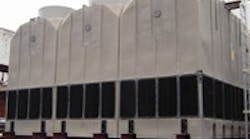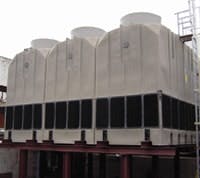Plastic cooling towers outshine galvanized metal
If you’re a utilities manager at a major chemical plant, corrosion of cooling towers should come as no surprise; it’s a fact of life. How you correct the problem is another matter because there are many products to choose from. Yet countless American corporations are turning to towers engineered with rugged plastics such as high-density polyethylene (HDPE) that remain impervious to harsh chemicals, bitter environments and pH deviations.
Countless American corporations are turning to towers engineered with rugged plastics, such as high-density polyethylene (HDPE), that remain impervious to harsh chemicals, bitter environments and pH deviations.
That was the decision Albemarle Corporation made for its fire-retardant plant in Magnolia, Ark. A galvanized metal tower had been badly compromised by the chemical environment. The plant specializes in products that help plastic molders, compounders and foamers meet or exceed stringent legal and regulatory requirements to protect property. Each flame retardant also helps save lives. They wanted to save a new cooling tower from the same fate as the one being replaced.
William Wright, a unit leader for Albemarle’s utilities department, said company officials took a sensible approach to the decision. “We looked at reasons why it failed. Among other things, the tower was sitting right next to components that had the potential to give off corrosive vapors. We needed something that could withstand that — and a whole lot more.”
|
View more content on PlantServices.com |
Wright called HDPE the “ideal material” for replacing Albemarle’s traditional metal-clad cooling tower. Just as plastics have overtaken metal for applications ranging from plumbing to aerospace, they are now eliminating the need for metal in cooling towers for a broad range of applications. In fact, the fire retardant plant already was using piping made from plastics when officials decided to buy a tower developed by Delta Cooling Towers Inc., of Rockaway, N.J., which has been manufacturing factory-assembled, noncorroding polyethylene cooling equipment since 1971.
Wright said the new tower has functioned without a hitch, and it has helped save money. Since the interior surface of the tower is dark and protected from the sun, water temperatures remain cool with less biological growth. As a result, treatment chemical usage is down. “I’d like to replace about 10 more,” Wright says.
During the next five years, Wright might get his chance as Albemarle fulfills its plan for upgrading the plant’s other 26 towers and equipment of various kinds. The overhaul comes at a time when the global corporation headquartered in Baton Rouge, La., is expanding. It now develops, manufactures and markets specialty chemicals for consumer electronics, petroleum and petrochemical processing, transportation and industrial products, pharmaceuticals, agricultural products, and construction and packaging materials.
“You try to get all the value you can out of something you’ve paid for. That’s where we are now. We’ve got a five-year plan. We’ll take a look when the time comes. We keep a good eye on maintenance,” he said.
Low maintenance, easy installation
Using advanced resins and molding techniques, engineered plastic cooling towers are available today in larger sizes and modular configurations that make them ideal for even high-capacity applications (1,500-2,000 cooling tons) that traditionally depended on expensive field-constructed installations. The plastic towers are easier to install because they weigh 40% less than their metal counterparts, yet they are five to 10 times thicker.
Engineered plastic equipment often means less maintenance and therefore lower ownership costs. Traditional metal towers over time require process downtime for patching and welding areas that have corroded. Also, traditional designs will have more complicated fan systems incorporation gearboxes or belts and pulleys that wear. Delta uses direct-drive fan systems that eliminate these maintenance items. Less moving parts equal less maintenance equals less costly process downtime and less aggravation.
Despite the advances in plastics technology, suggesting a plastic cooling tower can still draw some skepticism. Some business people hear plastic and assume it must be new and unproven. In fact, the technologies have been at work for decades, and the HDPE products have an excellent track record. Some business people used to a seven-to 12-year life cycle for galvanized metal may be surprised to learn that a plastic tower when installed may outlast their facility.
Wright expressed no skepticism about plastics, and like other managers is eager to embrace new technologies that will help reduce the daily trouble-shooting that is common at any large plant. “Most of our towers are quite old. They’re getting close to the end of their useful life. But a chemicals plant is a very corrosive environment. What do you expect? Even so, the plastic tower has performed to our expectations, in terms of heat transfer and all that. It now runs at 70% loaded, and we’re comfortable running it up to 100% soon.”
Although age and failing efficiency are the main reasons for upgrading equipment, Wright said some old cooling towers were built with materials that included asbestos. “We’re replacing those. Age makes them more difficult to maintain. And we’re to a point where we need more capacity.”
Corrosion problems can also be caused by pH levels for plants, hospitals and large corporate buildings in coastal locations. High or low (alkaline or acidic), a pH imbalance can trigger a destructive trend that causes metal-clad cooling towers to fail early or require extensive service. For example, a pH level lower than 4 can destroy the metal protective lining of a tower within months. And pH levels are affected by various harsh environmental conditions, such as sunlight and pollution — and even routine chemical treatments. HDPE towers are engineered to withstand pH deviations.
When replacing other towers, Wright and his colleagues will consider many issues such as flow rate and heat transfer capacity, and they will carefully analyze the conditions of the plant the new tower will service. They may even consider ceramic and stainless steel towers, though the cost of those types generally exceed HDPE products.
Although many questions will need to be answered, Wright has already made up his mind on one issue: “We won’t buy galvanized metal. The Delta tower is working just fine. I’m anticipating it’ll last a lot longer than what it replaced.”

